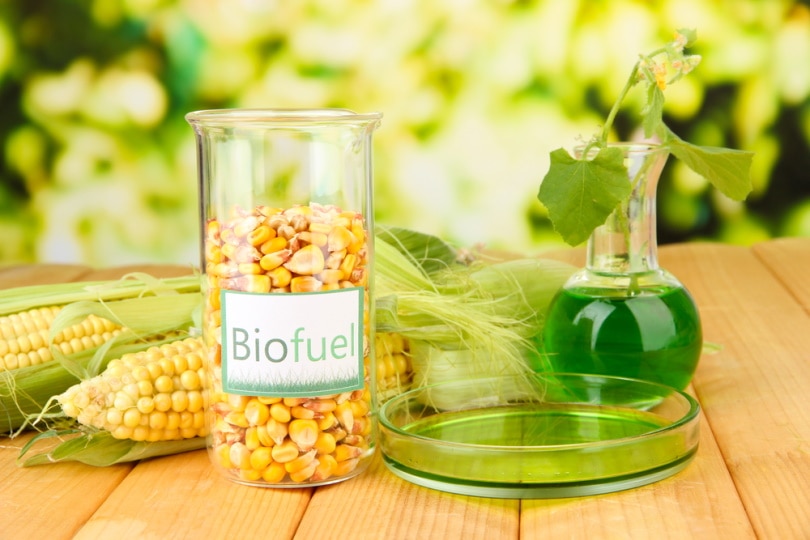Are Biofuels Carbon-Neutral? Facts, Types & Myths
-
Pete Ortiz
- Last updated:

The burning of fossil fuels is one of the biggest sources of CO2 emissions and emissions of other greenhouse gases. Since carbon dioxide emissions have kept rising over the past few years, our society is looking for improvement in methods of obtaining fuel. So far, the conventional, widely used standards were vehicles and other machinery powered by fuel that is irreversibly damaging our planet.
Since our civilization is heading to a path of no return, it is crucial to start looking for ways to improve our everyday life, beginning with the carbon footprint that we all create. One of the ways we can all contribute to the well-being of our environment is by accepting new methods of transportation, such as zero-emission vehicles and the use of biofuels which are carbon-neutral.
What Are Biofuels?
Biofuels are a form of carbon-neutral alternatives to fossil fuels that are primarily used for transportation needs. Biofuels use renewable energy sources such as organic waste, agricultural products, wood, or charcoal. These materials are most commonly obtained from plants and animal waste. By setting up a target for reducing greenhouse gas emissions, we are slowly working on healing our polluted sources. Biofuel is another invention that is a step towards that goal and so far, biofuel is an excellent substitute for fossil fuels.

What Does Carbon-Neutral Mean?
A carbon footprint is the amount of emission that any person can create during everyday activity. Carbon is emitted during driving, powering home appliances, and even in small amounts when you breathe. The air pollution in most parts of the world is worrying and needs a fast solution. Working on reducing CO2 emissions is a crucial step toward cleaner air. One step to ensure less CO2 emissions is creating fuel that only uses renewable energy sources.
Biofuels are the closest to carbon-neutral fuels that exist so far, being made primarily from animal waste and plants. Carbon-neutral is defined as a net-zero release of carbon into the atmosphere(releasing less than you create), usually as the result of carbon offsetting.
The 2 Types of Biofuels
Right now, there are two most commonly used types of biofuels, and they represent the first generation in the invention of biofuels. Both types of biofuels are made from renewable sources and are considered carbon-neutral. Even though these two types differ in the methods of production and their uses, they are very efficient and beneficial to the goal of reducing CO2 as much as possible.
1. Biodiesel
Biodiesel is a much more environmentally-friendly replacement for conventional petroleum diesel fuel. Biodiesel is a form of liquid fuel that is derived primarily from vegetable oils and recycled animal waste. In the United States specifically, most biodiesel fuel is made from soybean and palm oil.
One aspect that may be considered a drawback of biodiesel is that many forests and lands are cleaned and burned to make room for growing plants that will serve as biofuel. While this may be true, the benefits that biodiesel and other biofuels have to society are much more significant than the drawbacks.

- Excellent replacement for petroleum-based fuel
- Less CO2 emissions
- Uses only renewable sources
- Plants that go into making biofuels absorb CO2
- Some forests are cleared and burned to grow plants for making biofuel
- Some farmers are selling more crops for making biofuels than for making food
2. Ethanol
Ethanol is another form of liquid fuel made from renewable materials. Ethanol is primarily made from plant materials commonly known as biomass. A technique for turning biomass into ethanol is fermentation. In the United States, almost all sources of ethanol come from corn starch. Ethanol is most often used as a blend of gasoline and ethanol, with about 10% ethanol, while some vehicles can run on even 85% ethanol.
The ethanol-gasoline mix is widely used and about 97% of gasoline in the United States contains some percentage of ethanol. While some people may believe that the blend of gasoline with ethanol may harm your engine and your entire vehicle, this is not the case.

- Produced from waste materials
- Less expensive than other biofuels
- Promotes agriculture
- Reduces pollution
- The distillation process may harm the environment
- Large fields are needed for planting sources to make ethanol
Biofuel Myths vs. Facts
Many myths are circulating regarding the benefits and drawbacks of biofuel. It is essential to be informed to be able to differentiate between what is true and what is false. Below, we will list the most common myths that people believe about biofuels, as well as the facts.
Myth 1.
Biofuels emit more greenhouse gases than conventional gasoline fuel.
Fact: Biofuels are entirely biodegradable and use only renewable sources, which makes them much cleaner when it comes to CO2 emissions.

Myth 2.
The production of biofuels will cause food production in the United States to be drastically lower.
Fact: The United States can produce three times more than the biofuel’s production goal without disturbing food production.
Myth 3.
Mixing gasoline with ethanol can seriously damage your car’s engine.
Fact: The mix of gasoline and ethanol has little impact on vehicle performance.

Myth 4.
Ethanol and other biofuels have a much lower fuel economy than conventional fossil fuels.
Fact: All biofuels have the exact fuel economy as gasoline-based fuel and other fossil fuels.
Myth 5.
More energy goes into producing ethanol biofuel than the energy that is gained by using ethanol as a fuel.
Fact: One gallon of ethanol derived from corn delivers 67% more energy than is used for producing ethanol.

Myth 6.
The production of biofuels causes more CO2 emissions instead of reducing them.
Fact: Corn ethanol lowers greenhouse gas emissions by 20%, including all stages of production.
Summary
If you were wondering whether biofuel is carbon-neutral, the short answer is yes.
Biofuels are an excellent way to lower CO2 emissions and other greenhouse gases that may contribute to pollution. While we stated some benefits to biofuel and its production, it is essential to know that there are some minor drawbacks to this type of fuel, too. Overall, when you compare biofuel and the use of biomass, burning fossil fuel has much more significant consequences on the environment when it comes to CO2 emissions.
Featured Image Credit: Scharfsinn, Shutterstock
Contents



